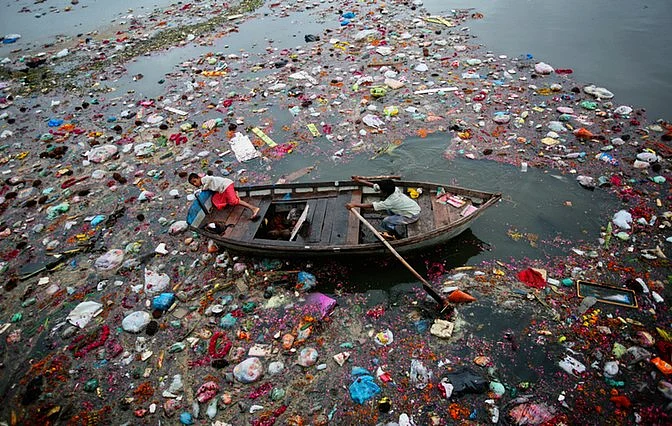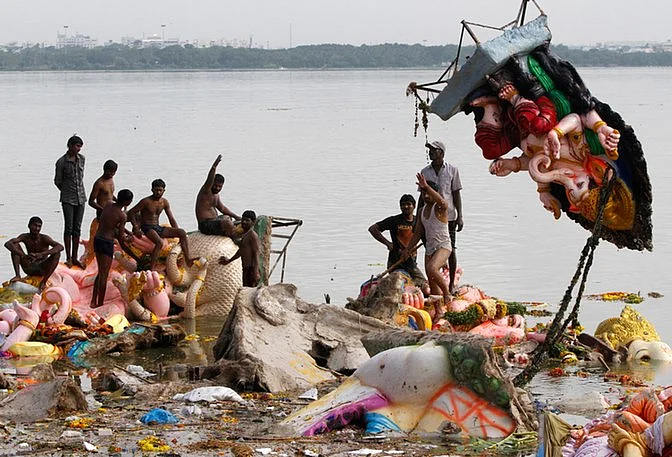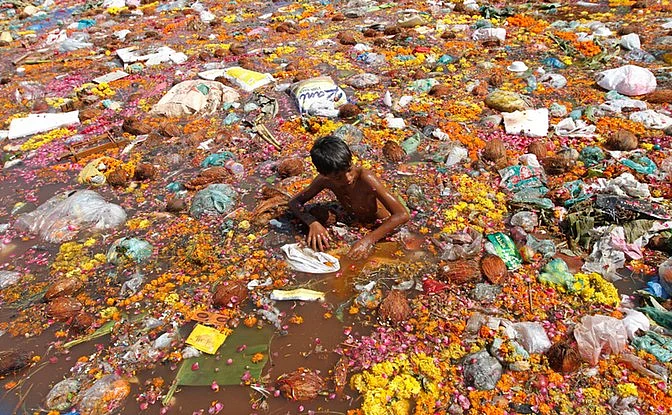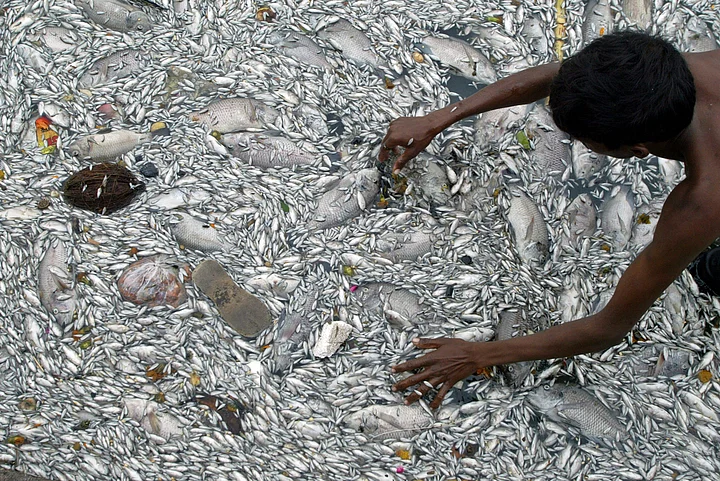Every year, the morning after Anant Chaturdashi, Mumbai lies comatose, finally.
After ten days of immoderate celebration welcoming, worshipping and bidding farewell to the beloved elephant-headed Ganesha; after ten days of fervent piousness and excess, the coastline of Mumbai looks battle-struck. Tens of thousands abandoned, suddenly unloved idols of Lord Ganesha decay in a sludge of flowers, incense, coconuts, leaves, stones, clay, jute, bamboo, clothes and food is strewn on the roads in tight plastic bags and otherwise, with a cloud of mosquitoes and flies swarming above it. There are no waves at some beach fronts; a black barrier of stagnant muck lines the shores.
And, if the aesthetic does not shock singly, there are always facts.
Let’s Talk About the Elephant in the Room
This year, in Mumbai alone, 2.25 lakh idols of Lord Ganesha will be immersed between 5-15 September. This includes 250 ‘big idols’ in what can only be called an understatement. Weighing a few tonnes, these idols stand at anywhere between 20-30 feet on an average with elaborate sets and thrones replicating temples and Bollywood scenes, inside massive community pandals , while the smaller household and locality idols can be found in pretty much any size, shape or form. On 9 September alone, 17,696 idols were immersed in Mumbai.
What happens to these fallen Gods, when the celebrations are over and the guests have all gone home? Turns out, these mass-produced, intensely commercialised statues are made months in advance by thousands of murtikars – each in its own right – using Plaster of Paris (PoP), an industrial material used in packaging. It’s cheap, easily accessible and works just fine, especially for larger idols.
Here’s the trouble: PoP when mixed with water, changes to gypsum – a soft, white, mucky substance – which breaks down painstakingly slowly over up to 17 years, increasing the quantity of both, floating and suspended particulate matter in the water and thereby, its hardness.
Not only did we shift from carefully made miniature Ganesha idols of mud and clay to exhibitionist, ever-expanding statues made of PoP, we also shifted from using organic dyes for colour to using lead and arsenic-based metallic paints. Again, cheaper (on a large scale), easily accessible and in this case, shinier.
These bright, synthetic colours contain heavy metals like lead, arsenic, mercury, cadmium, zinc oxide and chromium which lead to a decrease in biochemical compounds like oxygen, carbon dioxide, proteins, and lipids in the water, effectively decreasing the life-carrying capacity of water. The brighter the colour (red, blue, orange, green), the higher the toxicity.
And, then there’s the oil, grease and polish used to add that extra Godly factor to the idols.
If the trouble seems too far removed – as environmental concerns usually do – consider this: the heavy metals in these paints are bioaccumulative. Once they are inside marine life forms such as fish (those that survive), they pass up the food chain until they end up in the food we eat. They are also neurotoxic and nephrotoxic; ingestion, inhalation or contact with eyes and skin can lead to damages to the nervous and renal system.
To ask a believer if all this is worth the proportionally exponential damage it does to the very ecosystem that nurtures and preserves us – whether God exists, or not – is to tread a fine line between engaging in discourse and trespassing into the domain of personal choice. However, it doesn’t take a skeptic to see the very real, tangible environmental destruction that this religious festival asks for from its followers in its current avatar.
When the State Offers Polite ‘Suggestions’
In 2010, the Central Pollution Control Board (CPCB) woke up to the rising crescendo of alarm bells of environmental damage caused during and after Ganesh Chaturthi across India, particularly in Maharashtra, Goa, Karnataka, Gujarat, Tamil Nadu and Andhra Pradesh. It issued ‘guidelines’ for immersion of idols which if implemented, could actually improve the situation drastically.
These include earmarking and cordoning off certain ponds and lakes for immersion and notifying the public; constructing artificial tanks with removable synthetic liners to catch and dispose off all waste suitably; encouraging the use of clay over PoP, herbal colors over chemical ones; cleanliness drives after every immersion day within 48 hours to prevent seepage into the soil and the creation of an annual coordination committee by state PCBs consisting of the police, NGOs and members of religious groups.
Six years later, the CPCB guidelines remain what they are: guidelines. There are no requirements and no penalties. Giving the sensitive socio-political basis of Ganesh Chaturthi, especially the immersion process, it is not surprising that the state refrained from imposing any legal basis to its guidelines.
The state’s estimation of the religious force of the celebration is correct. Following the CPCB’s guidelines, Gujarat banned the use of PoP in making idols, asking murtikars to use “natural materials as described in the holy scripts”. A large group of idol makers challenged the ban in front of the National Green Tribunal which found in their favour. Recently, Karnataka has banned the sale of idols made of PoP. A recent survey by Bangalore’s Mahanagar Palika, KPCB and idol-makers found 30,000 PoP idols circulating in the city, with more than 70,000 on sale in the state this year.
If the scale and sentiments of the celebrations are too big for the state to meddle with, the environmental repercussions outweigh them comprehensibly- and urgently. To let this ritual grow out of control – as it seems to, with each passing year – for the fear of a two-penny religious backlash these days, only more damage will be done to our waters; the same water which ironically symbolises a returning to the sacred elements and the journey of Lord Ganesha to his heavenly abode, Kailasha, along with all our misfortunes.
(At The Quint, we question everything. Play an active role in shaping our journalism by becoming a member today.)




